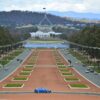
Climate Refugees and Australia
Officially, climate refugees don’t exist, but they will be rapidly multiplying in the years to come
By Chris Johansen, Green Issue Co-editor
If someone applied to the Australian government for asylum on the basis of being a climate refugee, they would be promptly put on a plane to return them to their country of origin. And the authorities would not have to worry about that pesky “non-refoulement principle”, which states that people who have crossed borders as refugees should not be deported or repatriated to their original countries against their will.
Why so? Climate change refugees are not covered by the 1951 Convention Relating to the Status of Refugees, which only offers protection to those fleeing war and conflict and who face persecution on the grounds of race, religion, nationality, membership in a particular social group or political opinion. Of course, humans were not worried about climate change and its possible consequences back then. Subsequently there were some regional refugee conventions like the 1984 Cartagena Declaration and the 1969 OAU Convention which offered a wider definition of providing protection to refugees fleeing conditions that “seriously disturb public order.” However, those conditions did not specifically include climate change related events. Thus, putting any moral considerations aside (which has been the backbone of Australia’s refugee policy over the previous two decades at least) Australia has no internationally legal obligation to accept even one climate refugee.
Nevertheless, this official denial of the existence of climate refugees cannot persist as the reality of their existence becomes more apparent day by day. Thus there is a growing realization of the need for an international mechanism to recognize them, classify them and protect them, in the same way that the 1951 Refugee Convention was intended to protect the then understanding of “refugees”. The UN Framework Convention on Climate Change (UNFCCC) has begun this process with the establishment of a Task Force on Displacement (TFD) at COP 21 in 2015. But, this is a long and winding bureaucratic process and it will be some time before any international binding agreement could be reached on how to humanely deal with climate refugees.
The first problem: how to define a climate refugee? A general, Oxford Dictionary, definition of a climate refugee is a person who has been forced to leave their home as a result of the effects of climate change on their environment. However, this is open to many interpretations.
First, from time immemorial humans have been forced from their traditional homes by extreme weather events, even though the long-term climate then was relatively stable. So “climate refugees” should really only refer to people displaced by extreme weather events that can be attributed to climate change. This attribution is fraught with uncertainty so we can only speak of increasing numbers of persons displaced by weather events whether directly attributable to climate change or are within the range of extreme events to be expected in a stable climate.
Second, the time scale over which different effects of climate change occur can vary. An increasing frequency of severe storms within a decade can have immediate effects on human displacement. However, the slow onset of a declining or changing rainfall pattern can gradually affect migration from rural areas, over decades. This causes migration to urban areas where unemployment and poverty abound.
Third, most people displaced by extreme weather events remain as internally displaced persons, within the boundaries of their home country. The term “refugee” is usually restricted to those crossing borders to escape trauma. And, for the internally displaced, if they move to another part of the country and find adequate employment and shelter there, are they really refugees?
Eventually, however, those displaced by climate change can fall into the realm of refugees covered by the 1951 Refugee Convention. The resultant poverty and movement into less climate-affected areas of a country can cause economic disruptions, social tensions, political instability and violence, causing those most affected to flee the country. An example is the increasing frequency and severity of hurricanes in central America exacerbating the already poor social and economic environment of those countries, resulting in increasing flows of refugees towards the USA border. Another is the increasingly erratic weather patterns of the African Sahel, and consequent food insecurity and political instability driving refugees north towards Europe.
So, it appears to be a two-stage process. Firstly, climate change inducing displacement of humans from their traditional settlement areas and, secondly, the social economic and political repercussions of the displacement. This displacement then, inevitably, pushes many people into the eligibility criteria of the 1951 Refugee Convention.
The now relentless march of climate change will inevitably lead to exponential increases in numbers of climate refugees, and ultimately 1951 Refugee Convention-eligible refugees, in the coming years. Many countries where climate displacement will occur, and is indeed now occurring, are already vulnerable to social unrest resulting from that displacement, causing increased refugee exodus from those countries.
One such country that I am familiar with is Bangladesh, much of the country being the delta of the Ganges and Brahmaputra River systems, with much of southern Bangladesh being less than five meters above sea level. Frequent cyclones and storm surges, with rising sea levels, cause increasing coastal damage and flooding, and salinity encroachment ruins once productive rice fields. This has been forcing migration from coastal areas for many years now, and this will only increase. It is predicted that 17% of the country will be submerged by the rise in sea level by 2050, and 20 million people living there will lose their homes.
Another such precarious delta system is the Mekong River Delta in Vietnam, where more than 20 million people now live.
Increasing frequency and intensity of tropical cyclones, attributable to a warming climate, will increase across Australia’s north, from The Philippines to Mozambique, where human populations number into the billions. And many Pacific nations have long been complaining that they are sinking under the sea. So, the potential for people falling into the category of climate refugees, and subsequently becoming eligible 1951 Convention refugees, wanting to come to safer places like Australia is huge.
In general, there are many countries where there is a confluence between a high population, high existing poverty levels, fragile governance systems and susceptibility to climate damage. Mainly countries in the tropics or sub-tropics ranging across Central America, much of Africa, South and South-east Asia and into the Pacific. A huge reservoir of potential climate refugees. Current estimates suggest that at least 1.2 billion people could be displaced by such climate-related events by 2050.
We are told that Australia’s “boat turn-back policy” of the previous decade has solved the “illegal maritime arrivals” problem. But we are not told of the fate of the boats and the people in them once turned back. “On-water matters” are not disclosed to the Australian people – they can only imagine. However, there are many other options for “illegal” refugee entry, which I won’t go in to. The reality is that boat turn-backs or other refugee exclusion methods will become less effective as climate change ramps up.
So what options for Australia? To reduce numbers of climate refugees desiring to come to Australia there are two.
Number one is to go gung ho on slowing down global climate change, by setting an example by reducing Australia’s emissions and participating whole-heartedly in a global push for emissions reduction (which means stopping export of fossil fuels for a start). Although there is now much backslapping over the recent passage of the “climate bill”, this is far short of going gung ho.
Number two, massively ramp up assistance to countries where climate refugees are emerging, such that those internal refugees can find alternative livelihoods within their own countries. However, this will be more difficult in countries where increasing drought is the major consequence of climate change, as in many parts of Africa.
Frankly, I don’t see governments of either colour in Australia going very far with either of these options and so an increase in refugees, originally displaced by climate change events, heading towards Australia seems inevitable, whether anyone likes it or not. The present policy of boat turn-backs and indefinite incarceration of “illegals” on Manus/Nauru or within Australia is not likely to be adequate for this scenario. It has already brought shame on the country from those in any way concerned about human rights.
Inevitably, contingency plans will need to be formulated for accepting a largely increased refugee intake, particularly of climate change induced refugees. Employment opportunities for such people seem to abound in Australia. It is claimed that the prime reason for the high cost of fruit and vegetables in Australia is lack of workers to pick, process and pack produce. As most climate refugees were originally farmers they would be well suited to such tasks. There are also claimed to be labour shortages in hospitality, disability support and recycling tasks.
However, it can be argued that an influx of unskilled workers would put further downward pressure on wages. Pre-covid, underpayment of temporary foreign workers and backpackers was rife, leading to downward pressure on wages. Close monitoring would be needed to ensure that unskilled refugees receive award conditions.
Just as climate change is predictable, although humans keep underestimating its rate of onset, rapid increases in numbers of climate refugees, however defined, is also predictable. However, Australia’s approach to this phenomenon has so far been to “bury the head in the sand”. A fortified border against climate refugees, like Trump’s border wall, will inevitably crumble as refugee numbers escalate. Thus, the Australian Government really needs to go gung ho on contingency planning on how to manage increasing numbers of climate refugees.
Header photo: A fishing boat carrying refugees from Somalia trying to cross the Indian Ocean, intercepted by a US naval ship. PH1 Robert R. McRill Public Domain
[Opinions expressed are those of the author and not official policy of Greens WA]
The content above from the originating party/author(s) may be of a point-in-time nature and edited for style and length. The views and opinions expressed are those of the original author(s). View original.
AusPol.co Disclaimer


